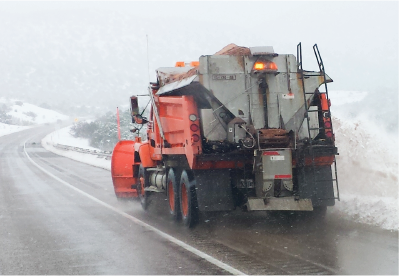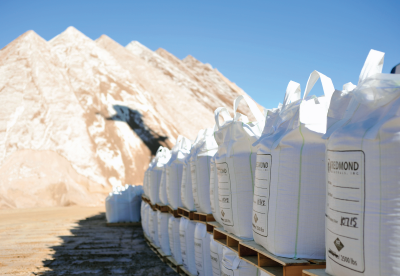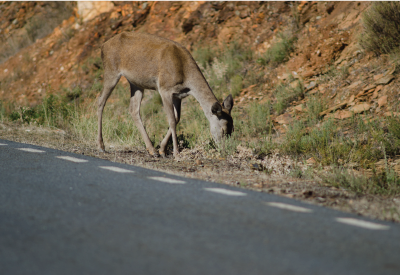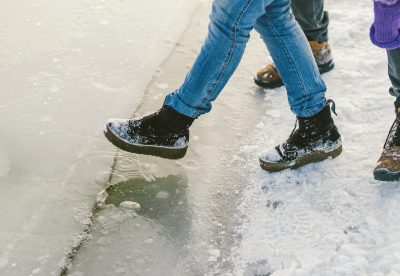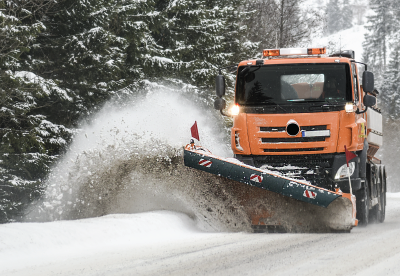Date September 4, 2024 | Brooke Loeffler
Top 15 Things to Prepare Your Home For Winter

1. HVAC Checkup
Your heater becomes the literal lifeblood of your home during the winter time. Book an HVAC checkup as early as possible in the fall. When the weather turns cold, HVAC professionals’ schedules fill up very quickly with emergency calls and it becomes more difficult to secure an appointment. Write down the number and point of contact of your HVAC service provider on your heater so you can find it easily in case of an emergency.
Cold and flu season can trigger a host of respiratory illnesses, so changing your air filters helps your winter start off fresh.
If your home has a hot water radiator, bleed the valves and release any air that may be trapped inside. Fluids are a much better heat transfer medium than air, so your radiator will work more efficiently without air pockets.
Next, take a look at your thermostat. If yours is on the old-fashioned side, consider upgrading to a programmable thermostat. Taking control of your heater’s schedule will prevent it from running unnecessarily and help you save immensely on energy costs. If you already have a programmable thermostat, make sure your heating schedules and temperature ranges match your current needs and lifestyle.
2. Seal Drafts and Leaks
A functioning heater is only part of the cozy home equation. Inspecting for drafts and leaks will seal out winter’s chill and save your heater from over-work. Start by walking around your home and perform an external visual inspection from roof to foundation.
Exterior Inspection (Look For):
• Shingles that are cracked, warped, or missing
• Moss or lichen on your roof (not just simple weathering discoloration, but masses that have pushed or dislodged roofing materials)
• Damaged or missing flashing around chimneys
• Damaged or missing weather stripping around doors and windows
• Cracked windows
Interior Inspection (Look For):
• Signs of water leakage in your attic or crawl space
• Gaps around doors and windows through which you can see light or feel airflow
• Drafts around outlet boxes or interior vents
After your inspection, replace and repair materials as your skill sets allow. Your roof should be top priority, so budget for roof repairs before anything else. If roof repairs are needed, schedule an appointment as early as possible before contractors are impeded by the weather. For drafty gaps around windows and outlet boxes, a can of spray foam insulation can provide a quick and simple fix. Weather stripping is also an easy material to apply around drafty doors and windows.
3. Repair Siding
Take a walk around your home, and inspect your exterior siding. Look for any siding that is peeling, rotting, or compromised in any way. No matter what medium (wood, stone, stucco, metal, brick etc.), if your siding is damaged, then the integrity of your home is compromised.
Any water penetrating a breach in the siding will expand once it freezes and exacerbate damage. Repair, replace, and reseal any siding materials that look like a weak link in your home’s armor against the weather. If repairing siding is outside of your skill set, consider hiring a professional before cold weather sets in.
4. Patch Concrete
Because water expands as it freezes, it is also important to inspect your home, paths, and driveway for cracks in any concrete or mortared surfaces. Patch, or fill in any cracks you find and reseal them so they do not fill with water and worsen upon frozen expansion.
5. Clean Vents and Ducts
Everyone loves a warm blanket straight from the dryer when it’s frigid outside. However, those comfy dryer loads can create a buildup of combustible lint in your vents. According to the US Fire Administration, clothes dryers fires cause major property loss each year. Most of these accidents occur during the fall and winter. Clean out your dryer lint traps and exhaust ducts so you can have peace of mind all winter long.
Another set of ducts that deserve a good clean is your air ducts. Air ducts can be simple to spot clean yourself, however if it has been awhile, consider hiring a professional for a deeper clean. If you decide to do this yourself, be sure to cover other vents in the house you are not working on so you do not force dust and debris into the rest of the rooms. Visit the EPA’s site to learn more about duct cleaning and how or when to get help.

6. Clean Chimney & Fireplace
Crackling fires are one of the upsides of those long winter nights. So get your chimney and fireplace up and running with a checkup to ensure they are working safely. Make sure the flue damper opens and closes correctly. Have your chimney and cap cleaned of combustible buildup, animal nests, leaf deposits, etc. Test gas fireplaces to make sure they are working before it gets cold.
If you have a wood burning fireplace, stock up on firewood and remove old ash deposits. Store firewood in a dry and easy to access location, however avoid storing it inside your home (wood piles can become insect hotels). Make sure fire extinguishers are not expired and that household members know their location and how to use them. Here are some additional tips on how to spruce up your fireplace before winter.
7. Check Smoke & CO Detectors
During cold weather, we seal our homes up to keep the heat in and save on energy costs. Then, as we run fireplaces and furnaces, our risk of carbon monoxide buildup and fires increases. Replace the batteries in both your smoke and carbon monoxide detectors then push and hold the test button to make sure they are functioning.
8. Check Drainage
Late fall, winter, and early spring create multiple freeze/thaw cycles that test any home’s drainage capability. Water must be diverted away from your home as much as possible. Inspect gutters and downspouts to ensure none of them are sagging, or have broken away from your roof line. Remove leaf litter and debris from your gutters to prevent ice dams (destructive icy blockages) that can build up against your home.
If the trees around your home make this a bothersome chore every year, consider installing gutter covers once they are cleaned out. If you are home on a rainy day, look at your downspouts and make sure water is not pooling against your house but immediately running away from it. Also on a rainy day, pay attention to any places in your yard where water is pooling, as these can become miniature ice rinks during the winter.
9. Prepare Animals
Some animals are naturally equipped for over-wintering, and some are not. For those that can live outside during sub-freezing temperatures, there are things we must do to make sure they stay healthy and safe in the months ahead.
Indoor Pets:
• Provide indoor sleeping areas for pets that may have been enjoying outside time during the spring, summer, and fall. They can still visit the great outdoors during the winter, but their living quarters should move inside with the rest of the family.
• If you have been storing food and other pet supplies outdoors for convenience, move your stockpile somewhere it will be easier to access once snow starts to fall.
• If pets do come outside, protect their sensitive paws from the cold and sharp ice. Purchase some pet booties and paw balm to help keep their paws healthy during the winter.

Outdoor Animals and Livestock:
• Outdoor animals and livestock should be provided with sheltered locations appropriate for their size so they can escape from winds and precipitation. These shelters can include coops, hutches, lean-tos, and 3 sided sheds depending on the animal.
• Acquire ample sand and gravel to spread for increased traction around food and water sources during the winter. Animals tend to congregate for warmth and can create trodden down bogs that fill with slippery ice and snow.
• Make sure you have a plan, and purchase supplies to give your outdoor animals access to unfrozen water every single day. Depending upon your local climate, it may be worthwhile to invest in a tank heater to help your animals get through lengthy freezes.
• Store food sources in a dry and easy to access location to make winter restocking easier.
• Here are some helpful tips from Redmond Equine on how to prepare and protect your horses for the winter.
10. Winterize Exterior Water Sources
One winter benefit is the break from typical yard work. Just as your plants will enter hibernation mode, it is time to put your exterior water sources to bed. Before it gets too cold, give your landscaping a nice drink before turning off exterior water. Remove and store garden hoses to prevent cracks and protect their shape.
Drain or blow out water from sprinklers and exterior valves before shutting off your landscape’s water supply. If you have any outside water sources that must stay on during the winter time, thoroughly insulate or consider purchasing pipe heaters as needed to keep your pipes from freezing and bursting.

11. Pest Prevention
Unwelcome critters want to enjoy the warm, safe space you have created in your home. Rodents, insects, birds, and even bats will try and find a way in to escape from the weather. Thoroughly check screens, window and door seals, exterior vents, soffits, facia, gables, and window wells for potential pest entrances.
Remember they can fit in remarkably small spaces! If you have plants or trees that drop nuts or other food sources, vigilantly remove them from the ground so your home doesn’t become their winter stockpile.
12. Prepare Outdoor Furniture & Lighting
Clean and dry outdoor furniture before covering them or bringing them inside. Be careful to not trap any moisture under furniture covers so you can avoid mildew growth. Clean and cover any outdoor grills or smokers and keep them outside. Never bring a grill or smoker to use in the house during the winter as they should always be used in a well ventilated area.
As the days get shorter, and darkness creeps earlier and earlier, take a good look at your outdoor lighting. Ensure your walkways have reliable illumination, especially those that lead to doors, gates, and outdoor storage. Replace bulbs as needed, and test light sources that you may not have used during the bright summer months.
13. Winterize Landscaping
It’s time to take another walk around the outside of your home, but this time look for branches that overhang electrical lines, vehicle parking, or are touching your home. Remove branches that, if they broke under the weight of snowfall, would damage structures or electrical lines below. Be considerate to your neighbors and avoid liability by tending to problem branches from your trees that could damage their property or structures. In addition, remove dead or damaged growth from trees because they will be the first to go during a storm.
If some of your plants require a winter fertilizer feed, apply as directed by the product packaging. Trim back your plants and mulch and cover according to their wintering needs.
Move temperature sensitive plants, bulbs, and pots (especially ceramic pots) to a sheltered location until spring. Mow over a portion of the leaf litter on your lawn so they can decompose and feed your grass during the winter. Don’t leave large leaf piles around because they can cause rotting.
• Learn more about preparing your garden for winter
14. Winterize Garden Equipment
Fall represents a great shift in the landscape tools we use on our properties. Bring all of your warm season tools inside (shovels, rakes, etc.) and treat metal components with rust prevention products. Reorganize your storage so that winter equipment is easier to access. Siphon leftover fuel from mechanized equipment (mowers, weed whackers, off road vehicles, etc.). You can either store it in approved containers or switch fuels over to vehicles or corresponding winter equipment. Be sure to use the correct fuel for the correct piece of equipment.
Depending on your equipment, additional pre-winter maintenance may be needed such as running antifreeze, changing oil, cleaning, etc. Follow your manufacturer’s guidelines for winterizing your equipment. Run a pre-winter test on snow blowers to make sure everything is functioning correctly before the snow arrives.
15. Acquire Snow Fighting & Emergency Supplies
If the last few years have taught us anything, it has shown us the importance of preparation. Acquire snow fighting and emergency storm supplies early so you have access to the best selection, and high inventory. Never wait until snow is on the Doppler, because that is when panic buying sets in, last minute shoppers clog retail lines, and inventories deplete. With that in mind, what should you stock up on?

Snow Fighting Supplies:
• Select the best snow shovel you can afford, as early as you can. Don’t get stuck with flimsy leftovers that won’t last the winter. Even if you have a snowblower, they can’t do the whole job. Shovels can help you get all the way down to the paved surface and are better to use on porches and tight areas.
• Try to purchase a wide, durable (but lightweight) shovel with a metal edge and ergonomic handles.
• Carefully research your deicing options and choose a product that is safe for concrete, plants, kids and pets.
• Acquire plenty of deicing product to last you the whole winter and additional fall and spring storms. If you have leftovers from last winter, place old product to be used before the new.
• Store your snow fighting supplies in a dry, easy to access location
Emergency Supplies:
• Create a household emergency plan and print out a hard copy that is accessible to everyone. Review and practice this plan as you assemble your kit. This plan should have locations and instructions for shutting off water, gas, and circuit breakers during the event of an emergency. Your plan should also include evacuation points and meeting spots. Household members may not be together during an emergency so make sure everyone has current contact information.
• Stock up on a decent supply of nonperishable foods, and water for each household member. Remember winter power outages can last for days and that in most areas, 3-5 is a safe number to plan for.
• Pack an emergency supply kit including batteries, portable radio, first aid supplies, lanterns, flash lights, and external phone chargers.
• If your budget allows, consider purchasing a generator that can help during a lengthy power outage.
• If you have ice chests, keep them in an easily accessible area. During an outage you can use snow and ice to store perishable food outside if the weather is cold enough. Remember, anything above 40° F is in the microbial “danger zone.”
Thank you for joining us in our preparations to make our homes safe for the winter.

• Get our Winter Home Guide!
Remember, purchasing the right deicer alleviates a lot of winter worries and restores winter fun! Nature’s Blend from Ice Slicer gives you the power of high performance road salt but is natural and safe to use at home with your children and pets. Click to learn more about plant, kid, and pet safe deicer in your winter supplies.
We wish you and your household a safe and happy winter season!
© 2024 Redmond Minerals Inc.

